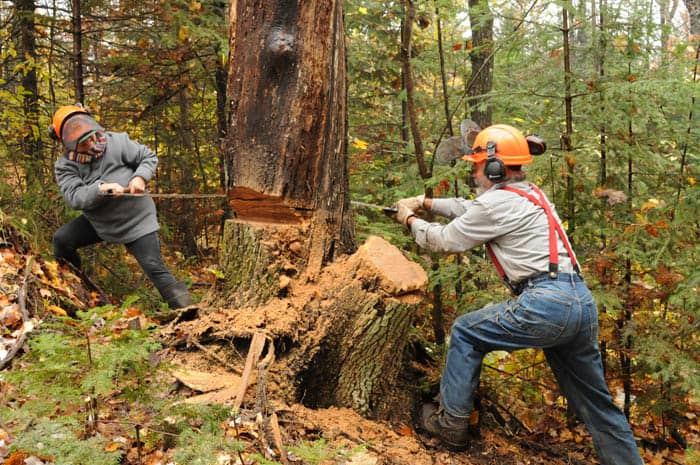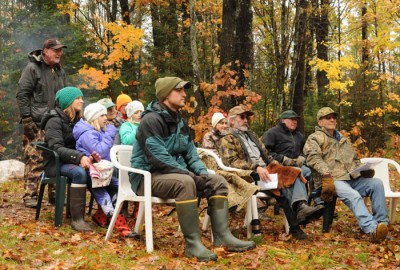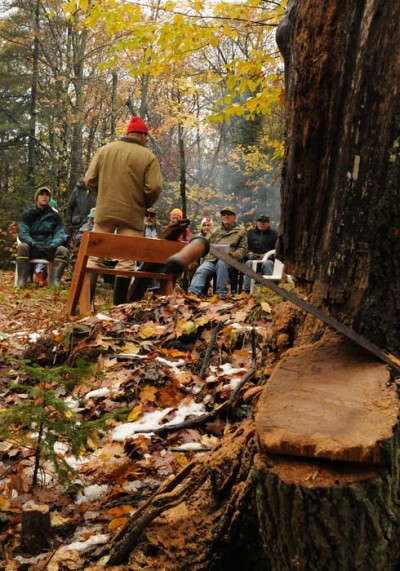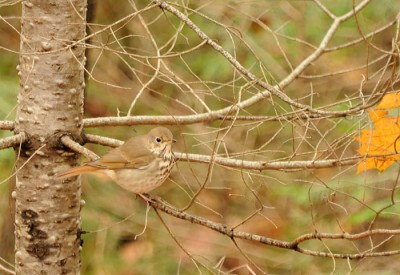Wisconsin Leopold Fans Reflect as They Reenact “Good Oak” Chapter
Patrick Durkin 10.30.14

When felling an old red oak by committee, you learn plenty about the tree, the land that nurtured it, and the animals, birds, and people who benefited from its long life.
That was just one lesson learned when 18 hunters, tree-huggers, and other conservationists of various ages and backgrounds gathered October 4 in northwestern Wisconsin to re-create the “Good Oak” chapter from Aldo Leopold’s famous book, A Sand County Almanac.

Leopold wrote the chapter after pulling and guiding a two-man crosscut saw through his lightning-killed oak north of Baraboo on the Wisconsin River in the 1940s. As he and his family cut, Leopold reflected on events during the tree’s 80-ring lifetime, roughly 1865 to 1945.
As he wrote: “Fragrant little chips of history spewed from the saw cut, and accumulated on the snow before each kneeling sawyer. […] Our saw was biting its way, stroke by stroke, decade by decade, into the chronology of a lifetime, written in the concentric annual rings of good oak.”
Likewise, my friend Tom Heberlein of Madison, Wisconsin, had an 80-year-old lightning-zapped red oak on his 40-acre property inside the Chequamegon National Forest. Heberlein figured it would be fun and educational to invite some citizen-sawyers to help cut down the oak while reviewing the Northwoods’ more recent conservation history.
Many folks sent him historical notes via email and standard mail, and a few even showed up to read their contributions aloud. Talk about stalwarts. They came, read, and listened for more than two hours in the midday’s chill, despite cold, wind, and drizzle that numbed ears and stiffened fingers.
After reading each decade’s notes, starting with the 2010s and working backward to the 1920s, they took turns sawing the oak. This was no small tree, either. Adrian Wydeven, a wolf biologist, measured the oak’s circumference at 69 inches and its diameter at 21.5 inches. In between measurements, he told how a cougar left its tracks along the nearby Conley Road in November 2012.

And on June 26, 2005, a two-year-old male wolf weighing 82 pounds was caught and radio-collared along Conley Road within sight of Heberlein’s oak. The wolf was likely a member of the Brush Creek pack, which still roams the area.
We also learned that when foresters dismissed mature pine plantations as monocultures in the 1970s, the US Forest Service suggested solving “the problem” by defoliating them with surplus 2,4,5-T (Agent Orange) from the Vietnam War.
“Citizens of the wood” fought the idea, said Janice Penn of Highbridge. “The planes were not deployed, the hands of those Northern woods people accomplished the necessary clearing. Forty years later, the Chequamegon Forest echoes, ‘We are here. We are here!”
As our saw cut deeper into the oak, we learned the Wisconsin Conservation Department quit feeding winter-stressed deer in 1954. Their analysis found the program cost $1,700 for each extra deer that hunters killed in fall. Heberlein noted his oak provided acorns at no cost to hunters.
This oak, however, owed its life to saws or fires that scoured the original forest from the landscape in the early 1900s. So said forester Matt Schultz, who found that Heberlein’s oak had sprouted from a stump, not an acorn, which explained its twin-trunked growth.
Until this red oak and many similar twin- and triplet-trunked trees nearby grew from charred stumps, this area was a short-lived farm field. Its soils were too thin and nutrient-poor to deliver more than one year of crops.
John Olson, of Ashland, knew something about those dream-shattering farms. His grandmother, Anna Olson, arrived in this area by train in 1919, and then sat on the loading dock with her two daughters and cried inconsolably about the fire-blackened desolation surrounding them.

When a realtor arrived the next year to take pictures of their crops—in hopes of selling more “farmland” to other gullible immigrants—Olson’s grandfather grabbed a pitchfork and chased the man away. Olson never forgot the story, because “When Grandpa said ‘pitchfork,’ he sprayed me with Copenhagen juice!”
In between their stories and historical footnotes, our gathering paired up, donned logger’s helmets, and grabbed a handle on the crosscut saw. About 90 minutes into the event, we finally cut past its midpoint, the tree’s pith year.
This prompted a question from biologist and outdoor writer Jerry Davis, who asked “why environmentally minded and outdoors-caring individuals do not follow the saw’s example of mixing chips from each and every year” as they work toward similar ends?
Meanwhile, our teams kept sawing toward the face cut, stopping occasionally to pound a wedge deeper behind the big blade, and pull a guiding rope continually tighter with a big truck. Finally, after about 8,000 words of conservation history and countless cuts from the saw, the good oak toppled and exploded into the ground.
As its admirers gathered for photos and to share yet more stories, hermit thrushes and yellow-rumped warblers flew in to hunt freshly exposed insects among the oak’s broken, fungi-covered branches.
A fallen oak is good for far more things than firewood, the birds reminded us.

